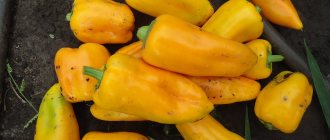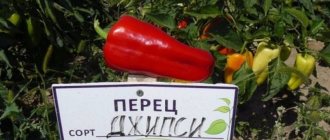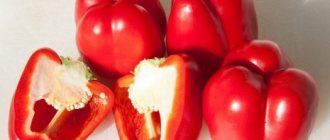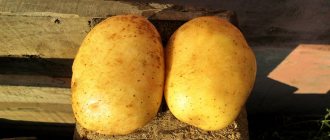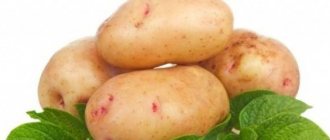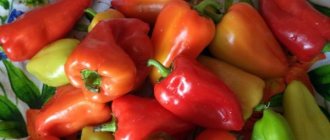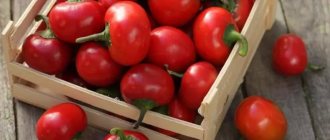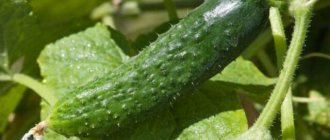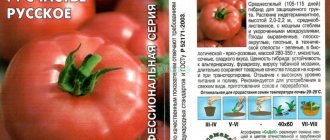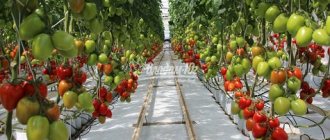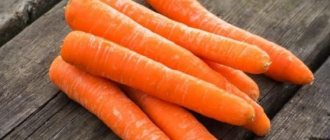What kind of variety is this
An early ripening variety produces the first harvest 90-100 days after planting. Gardeners characterize the vegetable as juicy and very sweet, and actively use it to prepare various dishes.
The bushes are compact and powerful, reaching a height of about 60 cm. The leaves are dark green, slightly ribbed. For best yield, the plant is formed 1-2 times per season. Otherwise, care does not require special knowledge.
Fruit characteristics and yield
The variety got its name for the large size of the fruit - the weight of one pepper varies from 350 to 550 g. The color is bright yellow, in some cases light pink. The shape is cuboid, slightly flattened. The wall thickness reaches 1 cm, so the peppers are perfectly stored and transported.
The pulp is dense and fleshy, crunchy when eaten fresh. The fruiting period of the variety is extended; on average, about 6 kg of pepper is harvested from 1 bush.
Characteristics and description of the variety
- Sweet peppers can be grown in greenhouses, in open soil.
- The culture has a semi-spreading, tall structure. The height of the bush can reach 60 cm.
- The fruit has a cuboid shape. The surface is glossy greenish-white and yellow.
- One fruit weighs 120 - 500 g. Wall thickness is 0.5 cm.
- The tasty fruits can be used to prepare hot dishes and preparations.
- The ripening speed is 65-70 days.
Preparation for cultivation
The quality of the future harvest largely depends on the quality of the seed. Calibration will help select the best seeds for planting - for this they are placed in a saline solution (50 g of salt per 1 liter of water). They are stirred for three minutes.
Those seeds that have sunk to the bottom are dried and used for further disinfection. It is necessary to destroy pathogenic microflora on the surface of seeds.
Gardeners recommend using one of the following drugs for disinfection:
- aloe juice;
- Bordeaux mixture;
- copper sulfate solution;
- "Fitosporin";
- boric acid.
The seeds are placed in a fabric bag and dipped into the prepared solution, left for 24 hours. Afterwards they are taken out and placed in a plastic bag for two days. This procedure increases the germination of pepper and protects against diseases.
Some summer residents advise soaking the seeds in a solution of the drug “Heteroauxin”. The growth stimulator strengthens the root system and promotes healthy plant development.
Important ! Particular attention is paid to preparing the beds. Since autumn, the soil has been dug up and cleared of debris and weeds. With the arrival of spring, the soil is dug up again, large clods and leaves are removed. The soil is leveled with a rake and fertilized with compost or humus.
Growing seedlings
Seedlings are grown in any convenient containers. Special seedling cassettes are popular - small containers fastened together with drainage holes . They are easy to use and affordable. At the same time, the size of the cassette can be easily adjusted to any window sill by cutting off the excess cell using scissors.
You can purchase seedling cassettes at any gardening store. If this is not possible, then the seedlings are planted in peat tablets, flower pots, and plastic cups. The main thing is to thoroughly rinse the container and dry it with a clean towel before planting.
For planting, in addition to containers, soil is required. Soil from the garden, previously disinfected with a solution of potassium permanganate, is ideal. The soil is poured into a container and lightly patted with your fingers or a spatula. Make small holes at a distance of 7-10 cm from each other, place seeds in them. Sprinkle the top with soil and water with warm water.
Sweet pepper is a heat-loving vegetable, so seedlings are stored only in a warm and sunny place.
Important ! Pepper does not like excess moisture, so it is recommended to water it sparingly. For watering, you cannot use cold tap water; it is better to moisten the seedlings with bottled or filtered water. After 10 days from the moment of planting, the seedlings are fertilized with liquid organic fertilizers.
10 days after the first leaves appear, the pepper is picked, that is, transplanted into a larger container. The procedure requires care and precision, since fragile and thin stems are highly sensitive. If possible, summer residents plant the vegetable immediately in a large container, so as not to pick the seedlings and accidentally break them.
Pepper Bugai
Description of Bugai pepper, reviews, photos
Mid-season, medium-sized, productive variety of sweet pepper for greenhouses and open ground.
The plant is semi-spreading, of medium height. The leaf is medium to large, dark green, wrinkled. How to shape the Bugai pepper, see the video below.
Sweet pepper Bugai is included in the State Register of the Russian Federation.
Fruit characteristics
The fruits are drooping, cube-shaped, glossy, greenish-white in technical ripeness, yellow in biological ripeness, weighing 84-120 grams. The number of nests is 4 or more, the wall thickness is 4-5 mm. The taste of fresh fruit is excellent.
Productivity : under film covers - 4.3-5.5 kg of fruits per 1 sq. meters of planting (subject to watering and fertilizing).
The variety is resistant to major pepper diseases.
Features of growing Bugai pepper, planting and care
Sowing pepper seeds for seedlings is carried out 70-75 days before the intended planting of plants in a permanent place. The optimal temperature for seed germination is 26-28°C.
When true leaves appear on the plants, they are transplanted into separate cups with a capacity of 0.3-0.5 liters.
Pepper does not like transplanting, so do not be surprised if after you have transplanted the seedlings into separate containers, they stop growing for a while. You can “smooth out” the stressful state a little by spraying the plants with Epin.
When to plant pepper seedlings in the ground
After the threat of return frosts has passed, the seedlings can be planted in a permanent location. Some people plant in open ground in May, while others only plant under covering material or under film; it all depends on the climatic conditions of your region.
When planting pepper seedlings in the ground for 1 sq. It is recommended to place up to 4 plants per meter of land, no more. Peppers are planted in the ground without being buried, but in exactly the same way as they grew in cups. Pepper plants, unlike tomatoes, very rarely produce lateral roots, so there is no point in deepening them.
Planting pattern in soil 50 x 50 cm.
Pepper responds well to watering and fertilizing with complex mineral fertilizers. During the summer, 2-3 feedings are usually done.
Forming sweet peppers, video
If you grew Bugai sweet pepper, please write whether you liked it or not. What was the yield under your climatic conditions? If possible, attach a photo of the entire bush or individual fruits you grew to your comment. Thank you!
Your reviews of the Bugai pepper and additions to the description will help you evaluate this variety more objectively and decide whether to plant it or not.
Planting pepper
Before planting each bush, carefully inspect the root system of the seedling. Sometimes young plants develop root rot, making them unsuitable for planting. Sweet peppers are planted after greens, legumes or cabbage. For landing, choose morning or evening; it is advisable that there is no rain or fog on this day.
The seedlings are carefully removed from the container and, together with a lump of seedling soil, placed in a hole in the garden bed. The stem around is sprinkled with earth and watered generously with warm water. In regions with unpredictable climatic conditions, it is recommended to cover the bushes with a plastic bottle or polyethylene. Such protection is removed after the likelihood of frost disappears.
Important ! The optimal distance between bushes is 60 cm. It is not recommended to plant plants too close to each other to prevent a lack of sunlight, which is necessary for normal development.
Care
Caring for the Bugai pepper variety consists of several procedures. The most important thing is timely and regular watering of the plant. It is produced 2-3 times a week: moisture should get under the root of the plant, bypassing the leaves and stems. 1-2 liters of water are consumed per bush.
It is important to prevent the soil from becoming waterlogged, as this can lead to the development of fungi and infections. After the procedure, the plant is spudded with moist soil. As soon as the soil dries, begin loosening the row spacing. This helps protect the beds from weeds such as bindweed or dandelions.
The taste and quality of the fruit largely depend on fertilizing, which is carried out twice a month. The following composition perfectly fertilizes peppers: dilute 20 g of potassium chloride and 30 g of superphosphate per 10 liters of water. Apply the mineral complex on a cloudy day, then water it generously so as not to burn the leaves.
We must not forget about organic fertilizers. A mixture of water, slurry and wood ash has a positive effect on the vegetable. During the entire ripening period, peppers are fed 3-4 times. Gardeners advise alternating mineral complexes and organic fertilizers.
Important ! A month after planting the pepper in the garden, they begin to form a bush: side shoots that are too long are shortened, and all the leaves that shade the crown of the bush are removed. Pruning is carried out once a week.
Features of cultivation and possible difficulties
When growing vegetables in a greenhouse, you must follow some rules. For example, regularly ventilate the building by opening side windows and doors. As soon as the outside temperature reaches +30 °C, the glass covering of the greenhouse is sprayed with a chalk suspension from a spray bottle.
The greenhouse must be light; the use of dark and shading surfaces is not allowed. Watering is carried out before lunch so that the moisture is distributed evenly. The greenhouse is characterized by a special microclimate, so a good harvest can only be achieved if all the rules described above are observed.
Particular attention is paid to loosening the soil. The quality of the soil and the healthy development of the root system depend on it. Loosening increases the access of oxygen to the soil, destroys the soil crust, and prevents the appearance of weeds. Loose soil absorbs water better. Near the pepper, loosening is best done to a depth of 10-15 cm.
After the procedure, it wouldn’t hurt to add a layer of mulch to the beds. It protects the top layer of soil from weathering and pests. The best mulch composition is sawdust, bark and grass.
This is interesting:
How to dry bell peppers: preparing a healthy and tasty culinary ingredient.
Red pepper and paprika: how they differ from each other.
Typical diseases and pests
Regardless of where they are grown, sweet peppers are susceptible to insect pests. Most often found in the beds:
- Thrips are black bugs. They appear due to an excess of fertilizing and sudden climate changes. Spraying with Bordeaux mixture helps as a preventative measure; Oxychom is used for treatment.
- Whiteflies are flying white midges that gather in flocks on leaves and suck the sap from the bushes. Spraying with a soap solution helps in the fight against them.
- Spider mite - envelops stems and leaves with a white web, causing the bushes to dry out and the fruits to lose their hardness. To prevent its occurrence, use a solution of ash or water with salt.
- The Colorado potato beetle loves to feast on more than just potato leaves. Beetles and larvae live deep underground all year round and are difficult to get rid of. Some gardeners prefer to collect insects by hand, others use the Prestige product.
Diseases include powdery mildew and bacterial black spot. They appear due to violations of crop rotation rules, improper care, and soil contamination.
Both folk methods and professional remedies help in the fight against diseases. Particularly noteworthy are solutions based on hot pepper or mustard, soapy water, as well as Arrivo or Nurel preparations.
Pepper “Bugai”: early with extended fruiting
The variety is an early ripening variety, which makes it possible to obtain large, fleshy fruits before the onset of autumn cold weather, and is suitable for growing in open ground conditions and under film.
The plant is unpretentious and produces high and stable yields.
Description of the variety
Pepper bushes are strong, low, up to 60 cm in open ground, spreading, leaves are dark green, slightly wrinkled.
When ripe, the fruits acquire a pearly yellow color and have the following features:
- The average weight of peppers is 150-200g, the first fruits can reach larger sizes - up to 300g.
- The shape of the fruit is cuboidal, the length reaches 12 cm.
- The fleshy walls are 8-10mm thick.
- Being one of the first to ripen, peppers are mainly used for preparing salads and other vegetable dishes.
- Suitable for canning and freezing.
The variety is distinguished by early (95-100 days after germination) ripening of fruits. Fruiting is extended, the yield is 5-5.5 kg per sq.m.
Disease resistance
Most peppers are susceptible to the main fungal, viral and bacterial diseases of nightshade plants. They can only be avoided if you follow the basic rules of agricultural technology.
It is important to plant peppers in areas where crops such as tomatoes, eggplants, peppers or potatoes have not been cultivated for the last 4-5 years. If the plot is small and it is not possible to change the beds, or you are using a greenhouse, you need to pay attention to pre-sowing disinfection.
It is best to treat the greenhouse in the fall, after the harvest is completed, and all plant debris must be destroyed; the soil, walls and auxiliary equipment are treated with disinfectants.
Good results are achieved by planting winter herbs such as mustard and phacelia to improve soil health.
Despite the fact that peppers ripen early, temporary changes in temperature and humidity, especially in greenhouses, can cause a number of diseases, such as late blight, blossom end and other rots, stolbur, and blackleg.
There is no treatment for most of these diseases; the only way to avoid them is to carry out preventive treatment of plants.
Against fungal diseases, summer residents most often use three-time spraying of plants with copper-containing preparations or a biological agent - phytosporin. Among folk remedies, garlic infusions are used.
To combat pests of peppers that attack the foliage of plants - spider mites, aphids, slugs, repellent infusions of tobacco, garlic, and onion peels are most often used. Spraying is carried out twice with an interval of 5-7 days. Planting marigolds among peppers gives good results.
Advantages and disadvantages of the variety
The main advantage of the Bugai variety is its large fruits and pronounced taste. Gardeners note the juicy and sweet pulp, which is suitable for preparing many dishes. Peppers are used in salads, appetizers, soups and side dishes. The taste of the vegetable goes harmoniously with meat, poultry, fish and vegetables.
The fruits also look impressive and have favorable commercial qualities. Thick walls allow you to store crops for a long time. The Bugai variety does not require special skills to care for, but the best harvest is obtained on fertile and nutritious soils.
The disadvantage of this variety is that large fruits are not suitable for whole canning. The peppers don't fit in the jar, so you have to spend time processing them. Bugai is also occasionally exposed to common cultural diseases, especially in the northern regions of the country.
Features of the variety and etiology of the name
Bugai pepper got its name because of the size of the fruit, which under optimal conditions can reach 500 g. The main purpose of the variety is fresh consumption. Lovers of early vegetables are happy to grow this variety of pepper, because it has the necessary pronounced taste of salad bell pepper and is distinguished by thick walls (up to 1 cm thick), so juicy that they seem literally filled with juice.
Sometimes the crop does not have time to ripen in the middle zone, although the bush is full of fruits. When the soil freezes for the first time, the peppers stop bearing fruit. For most varieties going for canning, the main time for winter seaming is the end of summer, the beginning of autumn and until October.
The peculiarities of the variety include the excellent germination of seeds, which are collected with one’s own hands at the right time, and the need to grow it in a greenhouse from seeds into seedlings. In the spring, when the night frosts stop and the ground warms up a little, it can be planted in open ground.
Reviews
What do experienced gardeners and novice gardeners think about the Bugai variety? Here are a few comments from popular forums.
Irina, Omsk: “I like the variety, I’ve been growing it for 4 years. He has never been sick and always bears fruit well. I fertilize with manure and ash, the peppers grow large and juicy. Tasty both fresh and after processing.”
Mikhail, Izhevsk: “I plant bell peppers in a greenhouse; last season I planted the Bugai variety. The harvest was not bad, I collected 5-6 heavy fruits from one bush. Stores perfectly, I recommend it for planting.”
Marina, Orel: “The Bugai variety did not live up to my expectations; the fruits set slowly. After shaping the bush, the plant became ill with powdery mildew. We managed to cure it, but part of the harvest was lost.”
Growing conditions
According to the testimonies of those who were already involved in breeding this variety, individual vegetable bushes with the correct mineral bait reached 1.5 m, and it was possible to harvest without bending over if the bushes were properly and tightly tied up. At the same time, a standard combined mixture for feeding was purchased from a specialized store. The length of some fruits reached 30 cm, and the weight was up to 0.5 kg. The yield of the variety exceeded all expectations.
This is not surprising, because Bugai is a solid, strong, unpretentious hybrid, grown by professional breeders, growing in open ground and suitable for cultivation in a greenhouse. One of the positive aspects of this variety is its resistance to various fruit diseases.
Planting of seedlings is carried out 60-70 days before it is planned to be planted in open ground. For seed germination, the optimal temperature is considered to be from +26 to +280C. Those who grew seeds purchased in the store used conventional plant growth stimulants, which are commercially available and relatively inexpensive, and noted that the variety responded well to mineral fertilizing. Some craftsmen placed 5-6 plants per 1 square. m., but the majority planted 4.
